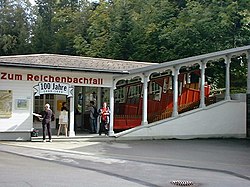| Reichenbachfall Funicular | |
|---|---|
 The lower station | |
| Overview | |
| Status | in operation |
| Owner | EWR Energie |
| Locale | Bernese Oberland, Canton of Bern, Switzerland |
| Termini | |
| Stations | 2 |
| Service | |
| Type | Funicular |
| Operator(s) | Kraftwerke Oberhasli AG |
| Rolling stock | 2 for 24 passengers each |
| History | |
| Opened | 8 September 1899 |
| Enhancements | 1999 |
| Technical | |
| Track length | 714 metres (2,343 ft) |
| Number of tracks | 1 with passing loop |
| Track gauge | Metre (3 ft 3+3⁄8 in) |
| Electrification | from opening |
| Operating speed | 2 metres per second (6.6 ft/s) |
| Highest elevation | 843 metres (2,766 ft) |
| Maximum incline | 61% |
The Reichenbachfall Funicular (German : Reichenbachfall-Bahn; RfB) is a funicular in the Bernese Oberland region of the canton of Bern, Switzerland. It links Willigen, near Meiringen, with the uppermost of the Reichenbach Falls, famous as the site of the apparent death of Sir Arthur Conan Doyle's fictional hero, Sherlock Holmes. On its route the line follows and crosses the lower falls of the Reichenbach. [1] [2]
Contents
The funicular was opened in 1899, and was rebuilt in 1999 to the original design. Between 1912 and 1956, it was linked to Meiringen by the Meiringen–Reichenbach–Aareschlucht tramway. Today it is owned by the EWR Energie company, which operates the adjacent hydroelectric power plant, but is maintained by the neighbouring Kraftwerke Oberhasli company, which also operates several other lines in the area. It has the following parameters: [1] [2] [3] [4]
| Feature | Value |
|---|---|
| Number of cars | 2 |
| Number of stops | 3 |
| Configuration | Single track with passing loop |
| Track length | 714 metres (2,343 ft) |
| Rise | 242 metres (794 ft) |
| Maximum gradient | 61% |
| Track gauge | 1,000 mm (3 ft 3+3⁄8 in) metre gauge |
| Capacity | 24 passengers per car |
| Traction | Electric |
| Speed | 2 metres per second (6.6 ft/s) |
| Journey time | 7.5 mins |
The funicular operates only between May and mid-October. During this period it operates every 15 minutes from 09:00 to 17:00.
The lower station is some 20 minutes walk, or a 6-minute bus ride, from Meiringen station on the Brünig railway line. [1] [5] It is 500 m from the Alpbach station.



